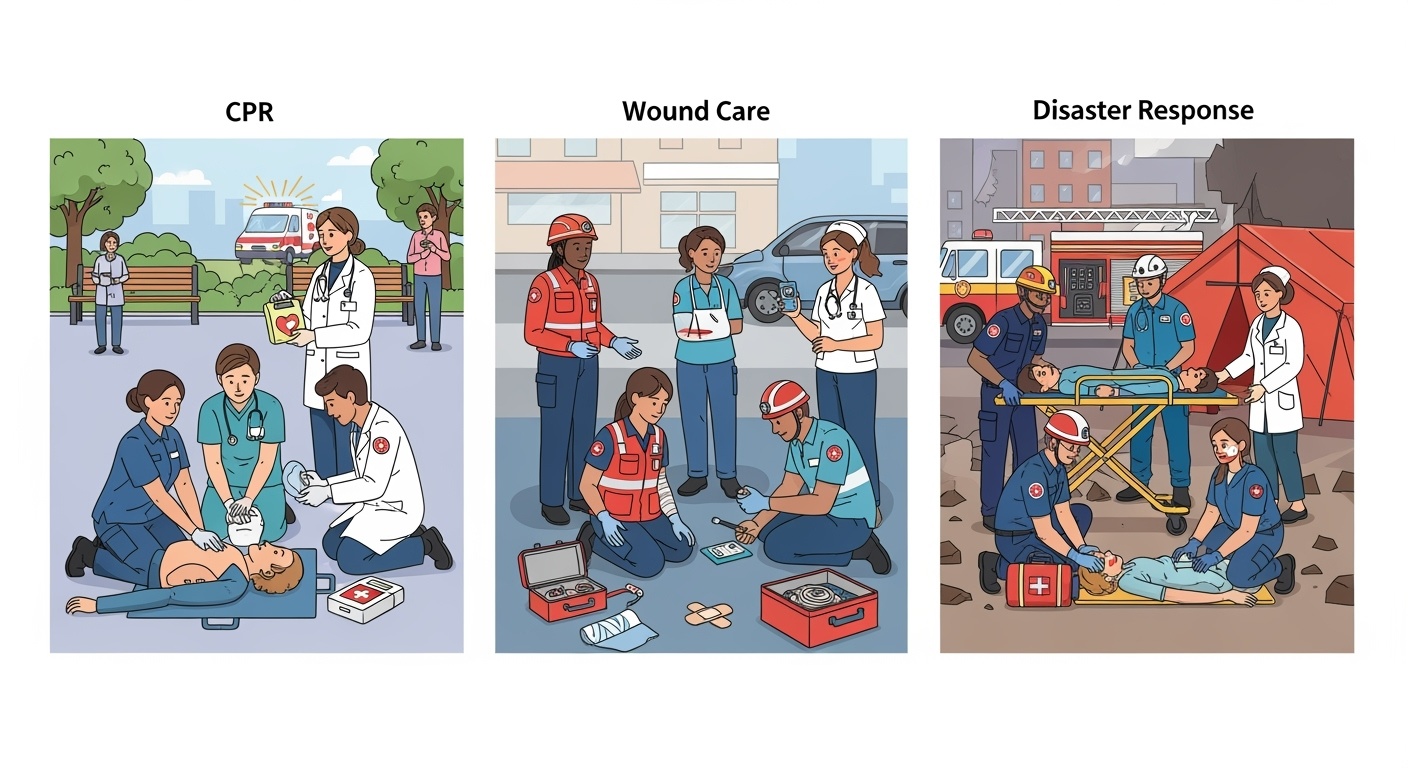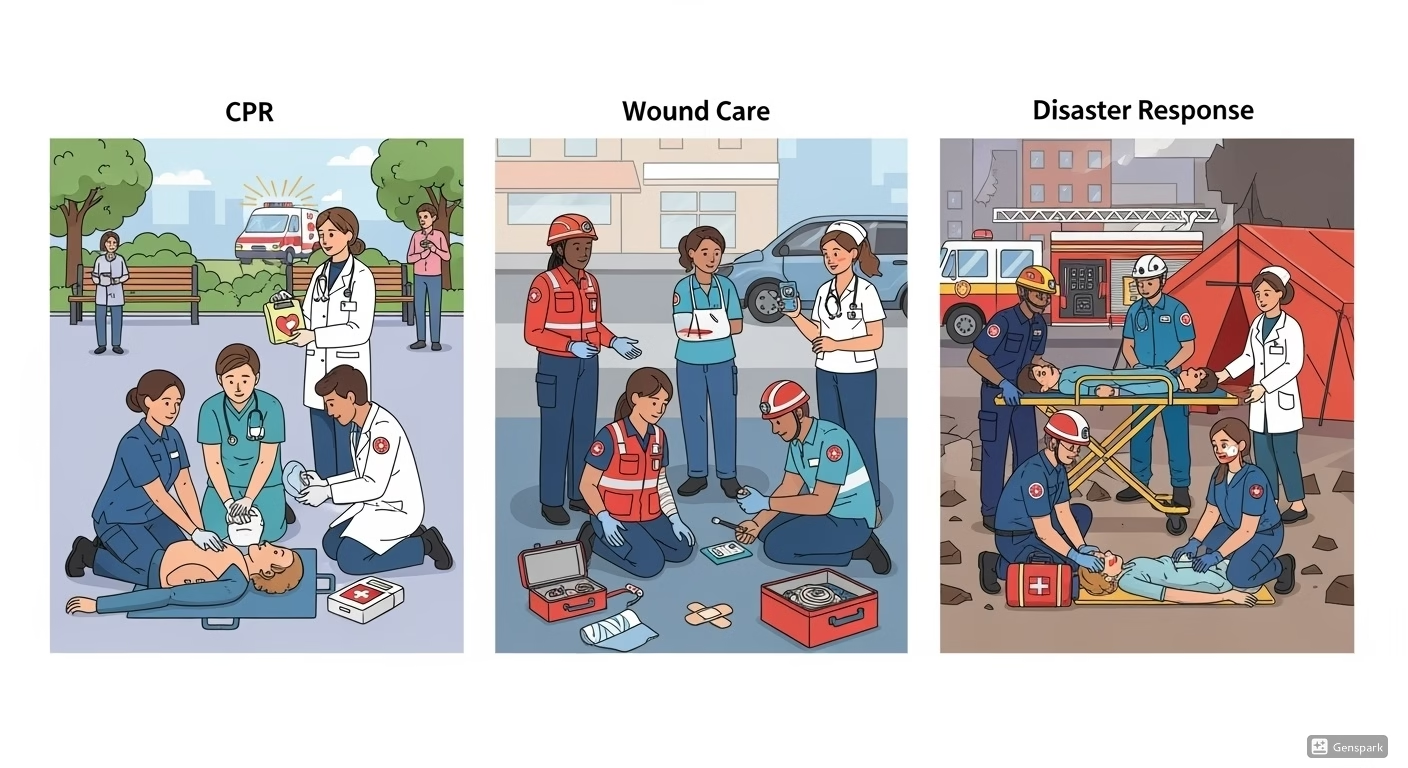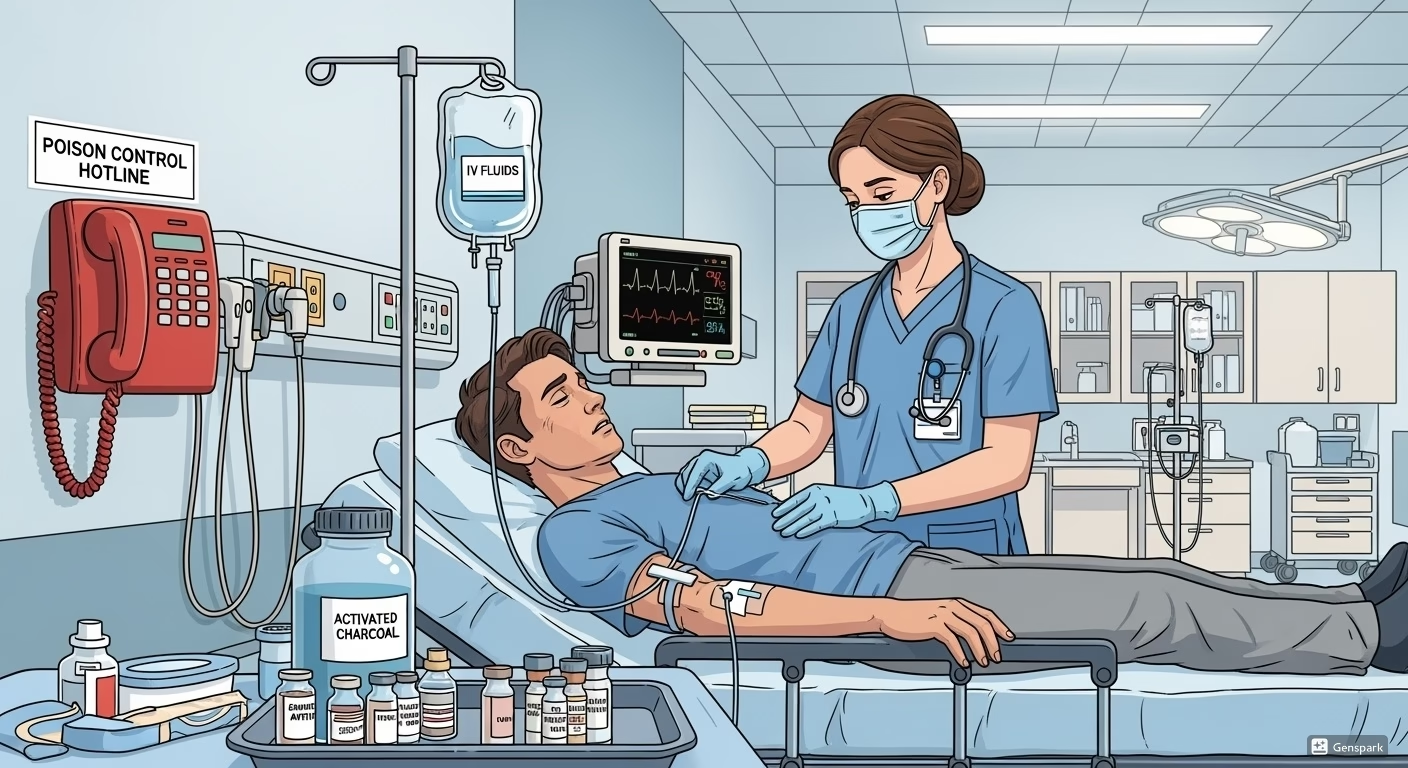First Aid Management of Community Emergencies
Comprehensive Nursing Notes for Healthcare Professionals

Table of Contents
1. Introduction to Community Emergency First Aid
Community emergency first aid encompasses immediate care provided to individuals experiencing sudden illness or injury in non-hospital settings. As nursing professionals, understanding these principles is crucial for effective community health intervention and emergency response coordination.
The primary goals of community emergency first aid include preserving life, preventing further harm, promoting recovery, and providing comfort until professional medical help arrives. Nurses play a pivotal role in community emergency response through their clinical expertise and leadership capabilities.
Memory Aid: The 3 P’s of Emergency Care
- Preserve – Life and limb
- Prevent – Further injury
- Promote – Recovery and comfort
Nursing Leadership in Community Emergencies
- Coordinate triage and resource allocation
- Provide clinical expertise in emergency decision-making
- Educate community members on basic first aid principles
- Advocate for vulnerable populations during emergencies
- Maintain professional standards under stress
2. Primary Assessment Protocol
The ABCDE Approach
Airway Assessment
Check for obstruction, positioning, and patency
Breathing Evaluation
Assess rate, quality, and effectiveness
Circulation Check
Pulse, perfusion, and bleeding control
Disability Assessment
Neurological function and spinal protection
Exposure & Environment
Temperature control and full body examination
Critical Decision Points
Immediate Interventions Needed:
- Airway obstruction
- Absent or inadequate breathing
- Severe bleeding
- Cardiac arrest
- Altered mental status
Can Wait for Advanced Care:
- Minor lacerations
- Stable vital signs
- Alert and oriented
- No immediate threats
3. Cardiac Emergencies
Cardiac Arrest Management
Sudden cardiac arrest is a leading cause of death in community settings. Immediate recognition and intervention are crucial for survival. The chain of survival emphasizes early recognition, early CPR, early defibrillation, and early advanced care.
High-Quality CPR Components:
- Compression rate: 100-120 per minute
- Compression depth: At least 2 inches (5 cm)
- Complete chest recoil between compressions
- Minimize interruptions
- Effective ventilations
CPR Memory Aid: “PUSH HARD, PUSH FAST”
AED Usage Protocol
Power On
Turn on AED and follow voice prompts
Apply Pads
Place pads as shown in diagram
Clear & Shock
Ensure no one is touching patient
Nursing Considerations for Cardiac Events
Assessment Priorities:
- Check responsiveness and pulse simultaneously
- Look for obvious signs of life
- Assess for DNR orders if available
- Consider medical history if known
Family Support:
- Provide clear, calm communication
- Designate family liaison if possible
- Prepare for difficult decisions
- Offer emotional support resources
4. Respiratory Emergencies
Airway Obstruction Management
Airway obstruction can be partial or complete, and may result from foreign bodies, swelling, or positioning. Quick recognition and appropriate intervention are critical for preventing hypoxia and cardiac arrest.
Universal Choking Sign:
Hands clutched to throat – immediate action required!
Conscious Adult Choking Protocol:
- Encourage coughing if able
- Position behind victim
- Place hands just above navel
- Give quick upward thrusts
- Continue until object dislodged or unconscious
Heimlich Maneuver Memory Aid: “5 and 5”
Special Populations:
- Infants: Back blows and chest thrusts
- Pregnant/Obese: Chest thrusts only
- Unconscious: CPR with airway checks
Severe Asthma Attack Management
Severe Signs
- Cannot speak in full sentences
- Accessory muscle use
- Cyanosis
- Altered mental status
- Silent chest
Immediate Actions
- Position upright
- Administer rescue inhaler
- Stay calm and reassuring
- Monitor breathing closely
- Prepare for deterioration
When to Call EMS
- No improvement with inhaler
- Severe distress
- First-time severe attack
- No rescue medication available
Critical Respiratory Assessment
Look For:
- Chest rise and fall symmetry
- Use of accessory muscles
- Skin color and perfusion
- Positioning preferences
Listen For:
- Stridor (inspiratory)
- Wheezing (expiratory)
- Crackles or rales
- Diminished breath sounds
5. Trauma Management
Bleeding Control
Severe bleeding is a leading cause of preventable death in trauma. The principles of hemorrhage control follow a systematic approach from least to most invasive interventions.
1. Direct Pressure
Apply firm, continuous pressure directly over wound
2. Pressure + Elevation
Raise injured area above heart level if possible
3. Pressure Points
Apply pressure to arterial pressure points
4. Tourniquet (Last Resort)
For life-threatening extremity hemorrhage only
Bleeding Control Memory: “STOP THE BLEED”
Spinal Injury Precautions
High-Risk Mechanisms:
- Motor vehicle crashes with high impact
- Falls from height greater than 3 feet
- Diving accidents or shallow water
- Sports injuries with axial loading
- Penetrating injuries near spine
- Blast injuries or explosions
Spinal Precaution Steps:
- Maintain head-neck alignment
- Minimize patient movement
- Use multiple people for log rolling
- Immobilize on rigid surface when possible
- Monitor neurological function
Trauma Nursing Priorities
Primary Survey:
- Life-threatening injuries first
- Systematic ABCDE approach
- Treat as you find problems
Documentation:
- Mechanism of injury
- Time of interventions
- Response to treatment
Family Care:
- Regular updates
- Prepare for outcomes
- Connect with resources
6. Environmental Emergencies
Heat-Related Illnesses
Heat Exhaustion
Treatment: Move to cool area, remove excess clothing, apply cool water, oral fluids if conscious
Heat Stroke
Treatment: Aggressive cooling, ice packs to neck/armpits/groin, immediate transport
Cold-Related Emergencies
Hypothermia
Treatment: Gradual rewarming, dry insulation, warm beverages if conscious
Frostbite
Treatment: Protect area, gradual rewarming, loose bandages, avoid rubbing
Temperature Emergency Memory Aid
HEAT Emergency: “ICE IT”
COLD Emergency: “WARM UP”
Environmental Emergency Danger Signs
Immediate Action Required:
- Core temperature >104°F (40°C)
- Altered mental status
- Absence of shivering in cold exposure
- Cardiovascular instability
- Severe dehydration signs
Prevention Strategies:
- Recognize high-risk populations
- Education on appropriate clothing
- Hydration maintenance
- Activity modification in extremes
- Early warning systems
7. Poisoning & Overdose Management
General Poisoning Protocol
Poisoning emergencies require immediate assessment and intervention. The key is identifying the substance, assessing the patient’s condition, and providing appropriate supportive care while contacting poison control.
Poison Control Center: 1-800-222-1222
Available 24/7 for expert guidance on poisoning emergencies
Assessment Priorities:
- What substance was involved?
- How much was taken?
- When did exposure occur?
- What is the patient’s current condition?
- Has any treatment been given?
Poisoning Assessment: “SAMPLE-T”
Specific Overdose Situations
Opioid Overdose
Alcohol Poisoning
Carbon Monoxide Poisoning
Nursing Considerations for Poisoning Cases
Safety First:
- Scene safety assessment
- Personal protective equipment
- Decontamination if needed
- Multiple victim consideration
Evidence Preservation:
- Save containers/packages
- Document all findings
- Collect vomit samples if directed
- Note environmental clues
Supportive Care:
- Maintain airway/breathing
- Monitor vital signs closely
- Prevent further absorption
- Emotional support
8. Neurological Emergencies
Stroke Recognition & Response
Stroke is a time-critical emergency where “time is brain.” Early recognition and rapid transport to appropriate facilities can significantly improve outcomes. Every minute counts in preserving brain tissue.
Time Windows for Treatment:
- tPA: Within 4.5 hours of symptom onset
- Thrombectomy: Up to 24 hours in select cases
- Golden Hour: First 60 minutes most critical
Stroke Recognition: “BE-FAST”
Seizure Management
During Active Seizure:
DO:
- Protect from injury
- Time the seizure
- Position on side if possible
- Stay with the person
- Note seizure characteristics
DON’T:
- Put anything in mouth
- Hold person down
- Give water or medications
- Leave person alone
When to Call EMS:
- Seizure lasts longer than 5 minutes
- No known seizure history
- Injury occurred during seizure
- Repeated seizures without recovery
- Difficulty breathing after seizure
- Pregnancy or diabetes present
- Person doesn’t return to normal
Status Epilepticus
Continuous seizure >5 minutes or repeated seizures without recovery – MEDICAL EMERGENCY!
Altered Mental Status Assessment
Rapid Causes Check:
- Hypoglycemia
- Hypoxia
- Drug/alcohol use
- Head injury
- Infection
Glasgow Coma Scale:
- Eye opening (1-4)
- Verbal response (1-5)
- Motor response (1-6)
- Total score: 3-15
- <8 = severe impairment
Immediate Actions:
- Ensure airway patency
- Check blood glucose
- Assess for trauma
- Monitor vital signs
- Prevent further injury
9. Disaster Response & Mass Casualty Management
Triage Principles
During mass casualty incidents, resources are limited and decisions must be made quickly to save the most lives possible. Triage sorting determines treatment and transport priorities based on survivability and resource requirements.
Immediate (Red)
Life-threatening but survivable with immediate care
Delayed (Yellow)
Serious but can wait for treatment
Minor (Green)
Walking wounded, minor injuries
Deceased/Expectant (Black)
Dead or unsurvivable injuries
Triage Decision Tree: “START Method”
Step 1: Can they walk?
YES → Green (Minor)
NO → Continue assessment
Step 2: Breathing?
NO → Open airway, recheck
Still NO → Black
YES → Check rate
Step 3: Respirations <30 or >30?
>30 → Red (Immediate)
<30 → Check circulation
Step 4: Capillary refill or pulse?
>2 seconds → Red
<2 seconds → Check mental status
Incident Command System (ICS)
Incident Commander
Overall scene management and coordination
Medical Officer
Triage and treatment area oversight
Transport Officer
Patient transport coordination
Safety Officer
Scene safety and hazard mitigation
Nursing Leadership in Disasters
Preparation Phase:
- Know facility disaster plans
- Maintain current certifications
- Understand community resources
- Practice triage scenarios
Response Phase:
- Rapid assessment and triage
- Coordinate with EMS/Fire
- Manage treatment areas
- Document for accountability
Recovery Phase:
- Debrief with team
- Psychological first aid
- Community resource connection
- Lessons learned documentation
10. Nursing Implementation in Community Emergencies
Professional Scope and Standards
Nurses providing community emergency care must understand their scope of practice, legal obligations, and professional standards. Emergency situations do not suspend professional accountability, but may modify practice parameters under Good Samaritan laws.
Nursing Process in Emergencies:
- Assessment: Rapid, systematic evaluation
- Diagnosis: Prioritized nursing diagnoses
- Planning: Goal-directed interventions
- Implementation: Evidence-based actions
- Evaluation: Continuous monitoring
Legal Considerations:
- Good Samaritan law protections
- Consent in emergency situations
- Documentation requirements
- Mandatory reporting obligations
- Scope of practice limitations
Emergency Nursing Priorities: “SAFETY”
Remember: ADPIE in Emergencies
Assessment → Diagnosis → Planning → Implementation → Evaluation (continuous cycle)
Communication and Coordination
Team Communication
- Clear, concise reporting
- SBAR communication method
- Closed-loop communication
- Conflict resolution skills
- Cultural competency
Family Engagement
- Timely information sharing
- Emotional support provision
- Cultural sensitivity
- Resource connection
- Advocacy role
System Integration
- EMS coordination
- Hospital communication
- Resource mobilization
- Follow-up care planning
- Quality improvement
Documentation and Quality Assurance
Critical Documentation Elements:
- Time of arrival and assessment
- Initial patient condition
- Interventions performed and time
- Patient response to interventions
- Communication with other providers
- Disposition and transport information
Quality Metrics in Emergency Care:
- Response time to scene
- Time to first intervention
- Medication error rates
- Patient satisfaction scores
- Successful resuscitation rates
- Adverse event frequency
Ethical Considerations in Emergency Nursing
Ethical Principles:
- Beneficence: Do good, promote welfare
- Non-maleficence: Do no harm
- Autonomy: Respect patient choices
- Justice: Fair distribution of resources
- Veracity: Truthfulness in communication
Ethical Dilemmas:
- Resource allocation in disasters
- Informed consent in emergencies
- End-of-life decision making
- Confidentiality vs. public safety
- Cultural and religious considerations
11. Additional Resources & References
Professional Organizations
-
American Heart Association (AHA)
CPR, ACLS, BLS certification and guidelines -
Emergency Nurses Association (ENA)
Professional development and standards -
International Association of Fire Chiefs
First responder coordination resources
Educational Resources
-
National Registry of EMTs
Educational standards and protocols -
American Red Cross
First aid and disaster response training
Quick Reference Contacts
Fire, Police, EMS
24/7 poisoning emergencies
Mental health crisis support
24/7 suicide prevention and crisis support
Mobile Apps for Emergencies
- PulsePoint: CPR alert system
- What3Words: Precise location sharing
- Zello: Walkie-talkie communication
- SkyAlert: Natural disaster warnings
Continuing Education Recommendations
Core Certifications:
- BLS (Basic Life Support)
- ACLS (Advanced Cardiac Life Support)
- PALS (Pediatric Advanced Life Support)
- CEN (Certified Emergency Nurse)
Specialized Training:
- TNCC (Trauma Nursing Core Course)
- ENPC (Emergency Nursing Pediatric Course)
- SANE (Sexual Assault Nurse Examiner)
- Disaster nursing certification
Leadership Development:
- Incident Command System training
- Quality improvement methodologies
- Cultural competency education
- Interprofessional collaboration
Key Takeaways for Community Emergency First Aid
Remember the Fundamentals:
- Scene safety always comes first
- ABCDE assessment guides priorities
- Time-critical interventions save lives
- Documentation supports quality care
Professional Excellence:
- Maintain competency through practice
- Lead with clinical expertise
- Advocate for patients and families
- Contribute to community preparedness


